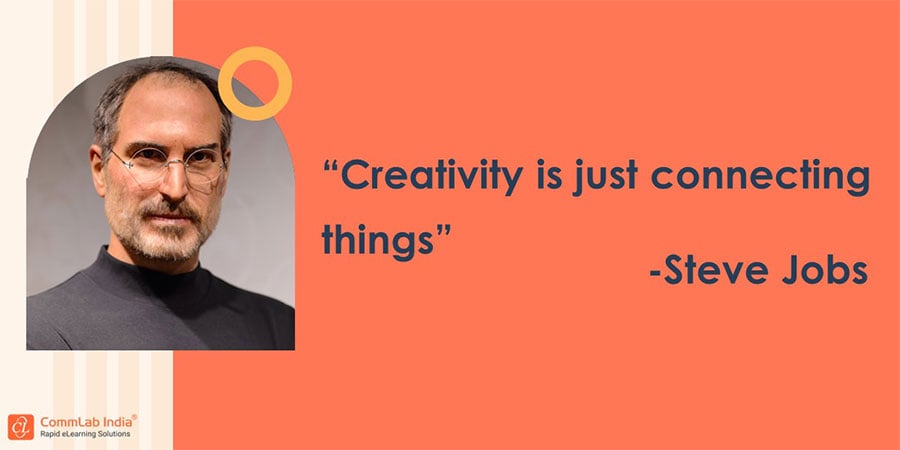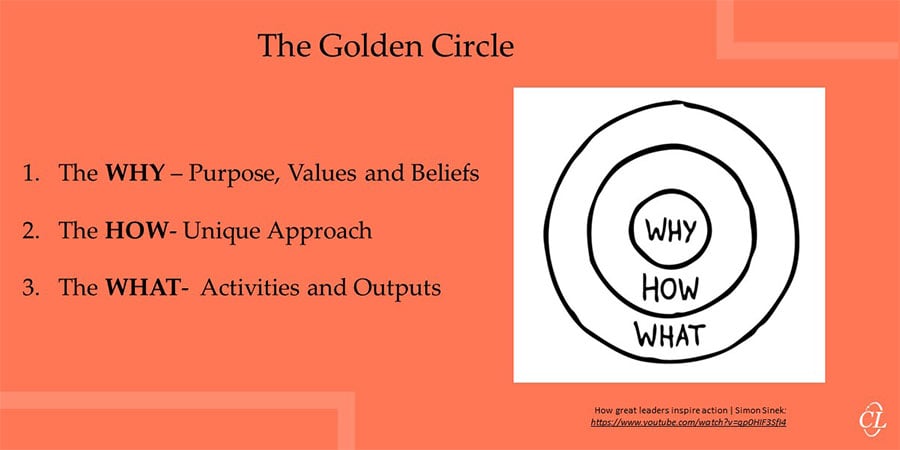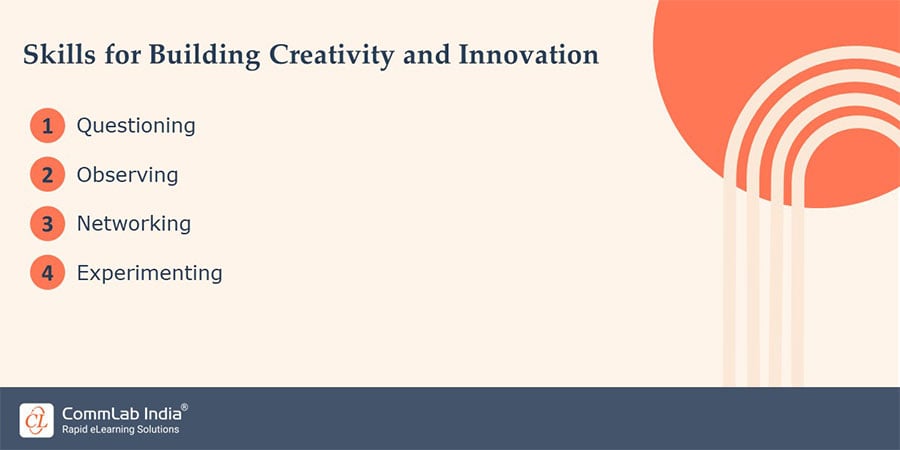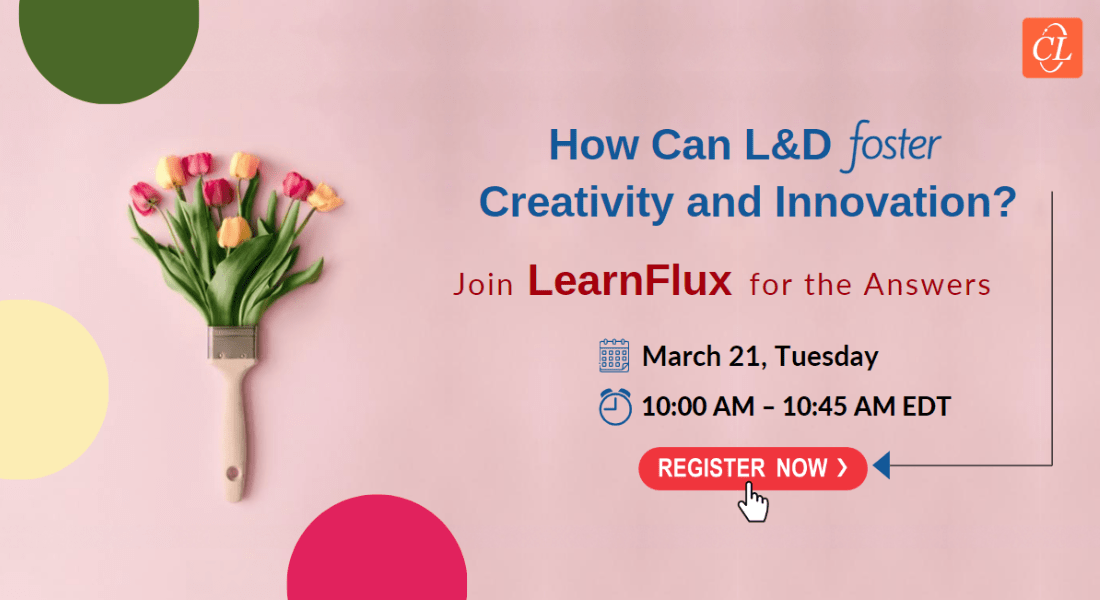4 Essential Skills to Build Creativity and Innovation in Learning

It is truly stated that when someone can be a creative person, they can be an innovator too. From doing something extraordinary like inventing a tool out of a need to something simple like finding a faster way to get to work when you’re running late, creativity and innovation can take any form.
How to Drive Creativity and Innovation in Learning?
By Building the Following Skills
- Questioning
- Observing
- Networking
- Experimenting
So, what does innovation and creativity really mean? And what is their impact in learning? Let’s start from their basic definitions –Innovation is to come up with new ideas that can be turned into something of value with the required skills. Besides, innovation is also looking at how to do things better or smarter.
And creativity is a function of curiosity and imagination. Greater the curiosity, more thoughts and thinking patterns emerge paving way for new ideas. To foster creativity and innovation in learning, it is necessary to shuffle and iterate the components of your knowledge base in new ways.

In a nutshell, innovation is the ability to develop ideas that enhance efficiency and add value, while creativity is the use of resources that we already have.
Importance of Motivation for Creativity and Innovation

Let’s understand its importance better with an author and optimist -Simon Sinek’s thoughts on motivation which he effectively explained through ‘The Golden Circle’.
The following principles of the Golden Circle can be used as a guide to vastly improve the way we learn.
- The WHY – Purpose, Values and Beliefs
- The HOW- Unique approach
- The WHAT- Activities and outputs
Golden Circle can be used as a guide to vastly improve the way we learn
We all know that Apple leads the technology sector but you will be surprised to know that it only makes up 3% of the global home computing market share. Its share being less did not keep it away from innovation which is why its impact is more when compared to other technology companies. All the credit for this goes to its innovation which made it an innovation leader.
This is a true example of how motivation is the key to innovation.
→ Download Now: Generating Motivation and Excitement in the Virtual Classroom [eBook]
Barriers to Creativity and Innovation
The two major constructs that keep us away from innovation in learning are-
- Status quo
- Fear
We frequently hesitate to adopt innovation out of concern for criticism and negative effects. We think that the choices we make while learning run the risk of having negative effects and causing loss. This fear takes charge and prevents us from innovating and learning in a creative way.
It is a major hindrance to innovation, and when it goes unchecked, it builds up into substantial barriers and turns the initial zeal for innovation into lack of interest.
On the other hand, status quo is another thing that hinders innovation. We frequently hold the opinion that since something is working well in learning and has done so up to this point, there is no need to change the way we go about doing it. With such a mindset, innovation is frequently hampered.
Skills for Building Creativity and Innovation

To innovate, one must move past the status quo, be willing to face their fears, take calculated risks and develop specific skills.
Going back to Steve Job’s quote of connecting things, you are driving innovation and creativity. And to get that right some skills are required, let’s discover about them in detail.
1. Questioning
Questioning is really the core discipline of creativity and innovation. It’s a kind of warmup for your thoughts that drive other discovery skills forward. When innovators are working on questioning sometimes the answer is less significant and finding the right questions has importance. But it’s often found that we will hold back from asking questions while learning. We constantly have the fear of pushing ourselves forward and opening ourselves up to inquiry.
But what really holds us back from asking questions? What are we scared of? It’s often being told that ‘YOU ARE WRONG!’ The constant fear of asking dumb questions and being ridiculed hampers us from thinking innovatively and asking questions.
When we talk about the skill of questioning, we all need to learn from children as they are fantastic inquisitors. Their questions are backed by an honest intent to learn and comprehend the world they live in and advance their skill sets. Something to truly learn from them!
The act of questioning promotes curiosity and paves the way for better thinking, ultimately improving the overall learning experience. Questions help think critically and exercise problem-solving skills. Moreover, questioning stimulates learner’s curiosity and motivates them to participate actively in learning and is the key for building creativity, curiosity, and empathy.
2. Observing
The ability to observe things is a special way to understand things when learning. To be an innovator there must be constant observing and gathering data which is to be applied in real life. It’s interesting and notable that creative and innovative individuals have an increased understanding of the “why” and “what” questions as a result of their exceptional ability to observe things in various and varied contexts.
Therefore, the ability to observe is a significant and integral component of learning and is essential to both creativity and innovation.
3. Networking
Inspiring learning opportunities are provided by networking, which can be used to build a community of creators and innovators. This opens the doors to new and better learning opportunities, and it’s a great way to acquire tips that you might not have come across otherwise.
When we network and connect, we understand its value because there are times when all we really need is someone who can relate to our creative and innovative side. In addition, networking fosters the development of a creative community by allowing you to share your ideas with others rather than keeping them to yourself.
4. Experimenting
Experimenting is a great way to gather data and figure out what might be effective in learning. This includes investigating ideas and discovering interesting new concepts. Experimenting is great because it enables us to return to the process of conquering fear. With experimenting, we can think big and take chances to try new things because we are aware that experiments don’t always succeed. It’s okay if something doesn’t work because failure is a necessary component of creativity and innovation.
It’s important to plan for the possibility that some of your ideas will seem brilliant but ultimately fail. However, by working through these ideas, you’ll learn what makes things successful and unsuccessful, which is what experimenting is all about. Failures are what teach us how to succeed, we need to experience failures in order to succeed.
Want to explore more about the necessary skills in learning? Watch this video to learn more
Wrapping it up!
As stated in the beginning, if you are creative, you can also be innovative, and the more innovative and creative you are, the more you accomplish and have an impact. So, rather than constantly planning for “the next big move”, bring innovation and creativity to what you’re already doing. When you do so, you ought to succeed.
Moreover, this technologically growing world needs the motivation to learn in a virtual environment owing to the distractions that come accompanied. So, are you looking for strategies to encourage motivation in your learners in the online classroom? Do you want to make learning in a virtual environment an exciting journey? Then access our free eBook today which offers tips and solutions to deal the difficulty of keeping your learners motivated and excited in the virtual setting.




![How Diversity and Inclusion Fuel Workplace Excellence [Infographic]](https://blog.commlabindia.com/hubfs/blogs/why-diversity-inclusion-workplace-infographic-1.jpg)
![The Secret to Developing Blended Learning Assets Quickly Revealed! [Infographic]](https://blog.commlabindia.com/hubfs/Imported_Blog_Media/blended-learning-rapid-elearning-info.jpg)